One of the questions we frequently encounter is how to putt on a golf simulator. While the answer is relatively simple, there are specific strategies to keep in mind to maximize your putting experience.
Most golf simulators are typically programmed to analyze putts, as part of how they are supposed to work, including start line and distance. Most simulation software displays a visual representation of the putt’s break on the screen.
While it may not replicate the experience of putting on a real green, there are ways to make the experience more realistic.
In this article, we’ll go over the topic of putting in a golf simulator, and provide some tips and tricks to help you perfect your putting game while enjoying the perks of indoor golf.
How Does Putting Work On A Golf Simulator?

Putting on a golf simulator can be achieved in several ways. The most common method is to putt a real ball into a designated hole on the simulator screen. This requires a bit of setup, as the simulator needs to be calibrated to ensure accurate readings of ball speed, launch angle, and green speed. Once the simulator is set up, golfers can use their own putters and balls to practice their putting strokes.
Alternatively, many golf simulators feature an auto-putt option, where the simulator will automatically putt the ball for the player (virtually). This option is convenient for those who want to focus solely on their putting stroke without the hassle of setting up each putt. However, auto-putt may not provide the most realistic putting experience.
Another option is to manually input putts into the simulator. This option requires the golfer to enter the distance, break, and other variables for each putt. While this may take more time and effort, it allows golfers to simulate different putting scenarios and can provide a more accurate representation of a real putting experience.
It is important to note that putting on a golf simulator may not exactly replicate the experience of putting on a real green. However, there are ways to make the experience more realistic. Longer turf mats can provide a similar feel to a real green, and adjusting for simulated conditions like green speed and slope can help golfers prepare for different courses and situations.
Additionally, using a separate putting green can provide a more accurate putting experience on a golf simulator. Many golf simulator setups with putting capabilities include a separate putting green that can be placed in front of the simulator screen. This allows golfers to putt on a more realistic surface and can make practicing putting more enjoyable.
Check Also: Best Golf Putting Aids of 2025
How Can a Golf Simulator Improve Your Putt?
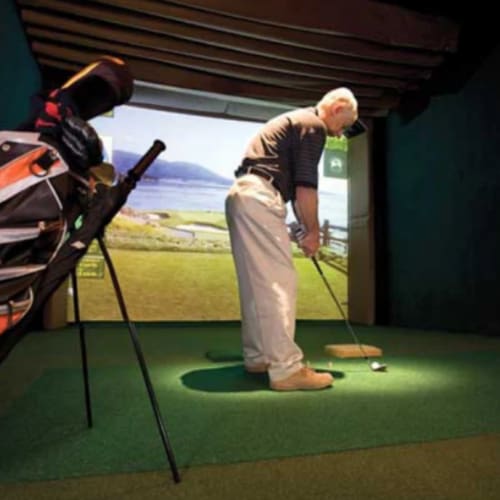
A golf simulator provides a virtual golfing experience and allows you to practice your short game in the comfort of your own home or indoors, as it tracks and analyzes your putting metrics.
The metrics will provide insights into your putting and help you pinpoint things you are doing right or wrong, which makes your practice sessions more purposeful.
With a golf simulator, you can use a sensor to putt a real ball or use the auto putt feature, which frees up more time to focus on driving and longer shots. Some sims come with a separate putting green, which can be used to build players’ putting skills and make them more well-rounded in their short game.
Some premium packages even include patented technology that helps recreate slope and undulations on the course and make the virtual experience closer to reality. These usually cost a lot of money (70,000+ dollars) and are usually inaccessible to the majority of players. Examples include the GolfZon setups and the Full Swing Virtual Green packages.
Auto putt is a cool feature that provides players with a practice option that allows them to work exclusively on honing their other game aspects. However, this option means not practicing your putting game indoors, which may be your only option if you don’t have enough room or if your hitting mat isn’t large enough for putting practice.
One major problem with putting on golf sims is the lack of depth-of-field perception; that is, you do not have enough distance to replicate the putt, like having to perform a 20-foot putt but actually having only 6 or 8 feet between you and the screen. You will need to imagine you are actually hitting for the 20 feet. Getting used to this situation may not be easy at first, but you will get used to it with enough time and practice.
Tips for Putting Using a Golf Simulator
Here are a few tips and advice to make putting in a golf simulator much easier and more realistic.
Set a Target to Aim For
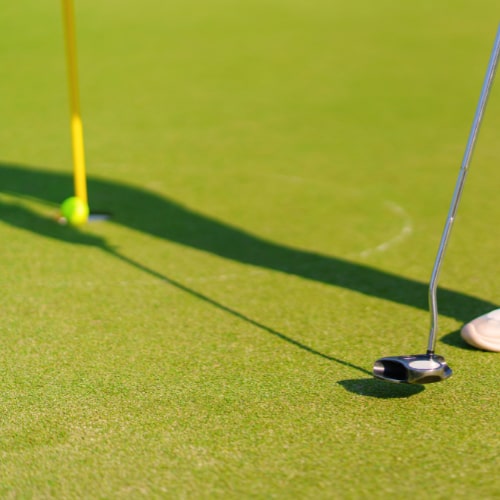
Having a target to aim for is particularly advantageous when using a golf simulator. Simulators are designed to read the initial launch of the ball and provide feedback on your shot accuracy, ball speed, launch angle, and more.
This means that if you have a clear target in mind, you have a better chance of hitting your intended shot, making the putt, and receiving accurate feedback from the simulator.
Setting a target will not only improve your performance on the green, but it will also help you develop a more consistent putting stroke. Using a virtual target to aim for can help train your mind to hit the same spot every time, which can translate to better putting in the real world.
So, the next time you’re playing on a golf simulator, be deliberate and set a target in the direction you’re hitting. Doing so will help you improve your focus, increase your accuracy, and provide you with more meaningful feedback from the simulator.
Feel the Green Speed
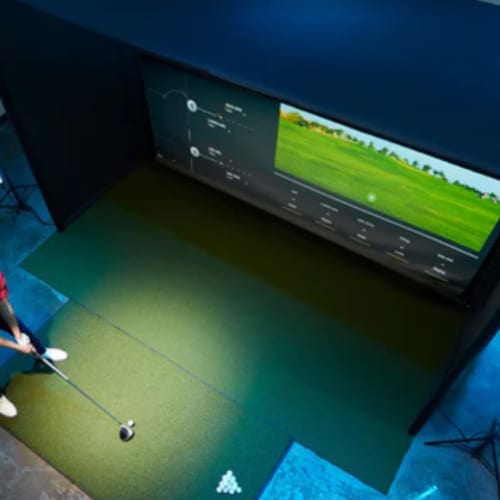
When using a golf simulator, one important factor to consider when putting is the green speed. The green speed refers to how fast or slow the ball moves on the green when it is struck by the putter. This is an important aspect to consider because it impacts the power needed for each putt.
To get a feel for the green speed, it is important to practice and observe. Spend time taking various putts and noting the power needed to get the ball into the hole. Through practice and repetition, you can learn to adjust your stroke to accommodate the speed of the green.
In addition to the green speed, the slope and direction of the green are also important factors to consider. On a simulated green, you can utilize any readings or information available on the simulator screen to aid in putting accuracy. This may include information about the slope and direction of the green, as well as any barriers or obstacles that need to be navigated.
It is crucial to take time to get familiarized with the green speed and other factors that can impact putting accuracy. By doing so, you will greatly benefit your performance on the golf simulator. Spending time practicing and experimenting with different strokes can improve your understanding of the green speed and how it can affect your putts.
Note: Getting a hitting mat that provides a life-like feel (closer to that of the real turf) will definitely help make things better! The slope of the simulated green should be considered, too; if there is a slope, putt for it (even if your hitting area is actually flat).
Measure the distance
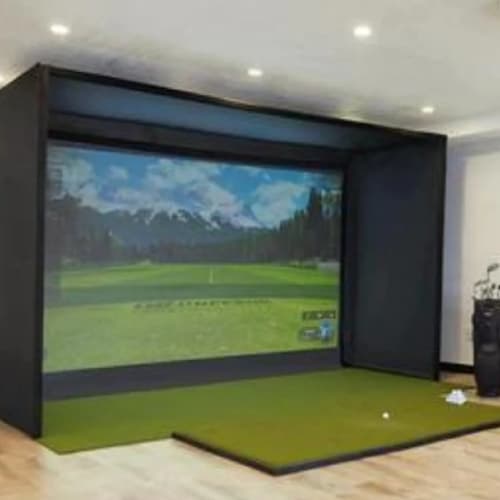
When putting on a golf simulator, one of the most crucial elements to consider is gauging the distance from the ball to the impact screen. Knowing the distance can help you hit putts with the right speed, allowing for more accurate shots and overall better performance.
The distance between the hitting area and the impact screen must be at least 6 or 7 feet, and it can be as long as 14′. Knowing the exact distance allows you to adjust the strength of your putt to achieve the specific virtual putt.
Also, knowing the distance of the virtual (simulated) putt you need to make (usually displayed by the sim) will help you perform better during your practice sessions. You can have an idea of how to make the perfect putt for each specific distance. As we said earlier, this may be challenging at first, but with enough time, practice and dedication, you will get there!
Gauging the distance is crucial for putting on a golf simulator, as it allows you to adjust your putt speed for shots of different lengths. By measuring the distance and adjusting your putt speed, you can hit putts with greater accuracy and consistency, leading to a more realistic and enjoyable putting experience.
Read the Greens
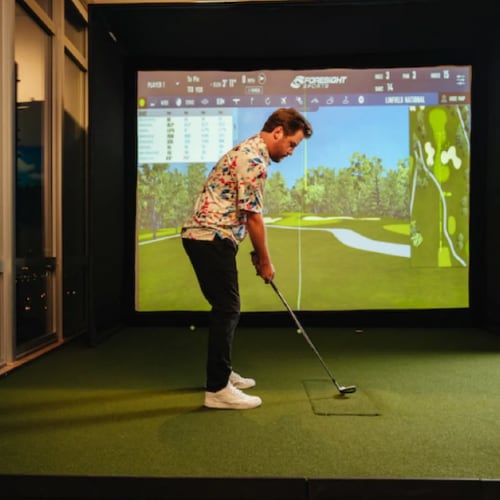
Getting used to the greens on a golf simulator can be a bit challenging. However, it is an essential part of the game and should not be overlooked. Here are some useful tips to help you get used to the greens when putting on a golf simulator.
Firstly, spend some time practicing on the simulator. Take note of the speed of the greens and how they differ from the real golf courses. The speed of the greens is critical to ensure the accuracy of your putts.
Additionally, take advantage of software systems that include grid lines to help you with reading the greens. These systems are designed to help you read the slope of the greens, and with time and practice, you’ll get used to them.
When studying the grid lines, focus on understanding how they relate to the slope of the greens. This will help you adjust your putts based on the slope of the greens and improve your accuracy.
Consider investing in a premium practice putting green like the Tour Links putting greens. These greens will help you adjust to a consistent stimp meter reading of around 11.5, which is the standard for most golf courses. Having a consistent stimp reading will help you get used to the greens and become a better putter.
Putt Like You Would on the Course
If you’re playing golf on a simulator, you want to make sure that you accurately replicate the experience of putting on an actual golf course. Fortunately, with a few adjustments, you can simulate putting like you would on the course. Here’s how:
Step 1: Line up the Ball
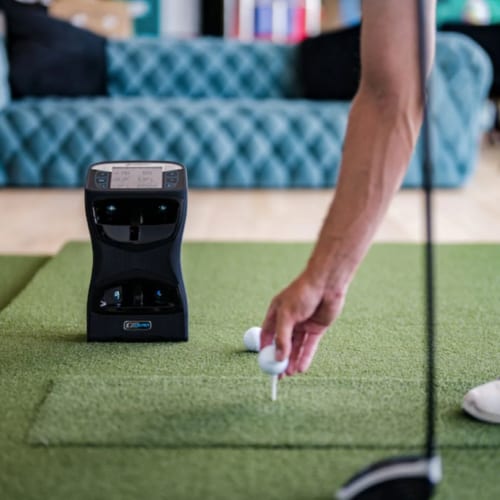
Start by lining up the ball based on the green’s speed and slope. Most simulators allow you to adjust this using the camera view. Ensure that the ball is lined up in the right direction and that it’s positioned correctly (vis-a-vis the tracking system).
Step 2: Take a Few Practice Swings

Take a few practice swings to get comfortable and gauge the distance. If you’re using a simulator for the first time, it may take a bit of time to get used to the feel of the putter.
Step 3: Putt the Ball
Next, putt the ball as you would on an actual course, using the same techniques and stroke. Begin your stroke back and through the ball steadily with a good follow-through. Don’t try to hit the ball too hard, as a gentle and precise putt can still travel a long distance.
Step 4: Focus on Force and Direction
As you’re putting, focus on hitting the ball with the right amount of force and direction. Take your time, as even a slight error can cause the ball to veer off the intended path.
Step 5: Get Used to the Greens
It’s crucial to get used to the greens, read the surface and make necessary adjustments. Pay attention to the slope and speed of the green (in the virtual session), and adjust your stroke accordingly.
Step 6: Set a Target
Set a target in the direction you’re hitting and keep putting until you’re confident in your stroke. Repeat the same shot process every time. Consistency is key to mastering the putt.
By following these steps, you can enjoy a realistic experience of putting on a golf simulator that’s very close to a real golf course experience. So, the next time you play golf indoors, remember to keep these tips in mind to Putt Like You Would on the Course!
Final Thoughts on Using a Golf Simulator for Putting Practice
If you are an avid golfer, you know that putting is a crucial part of the game. Putting support is an essential factor to consider when selecting a golf simulator, as many systems on the market offer advanced features, but not the ability to provide realistic putting practice.
Understanding how putting works on a golf simulator is key to getting the most out of your practice sessions and improving your performance on the green.
However, owning a high-quality golf simulator that provides accurate ball speeds, launch angles, and green speeds can significantly enhance your putting skills, whether you are playing for fun or improving your game.
Using a golf simulator for putting practice has its pros and cons. Besides the convenience of being able to putt anytime, a golf simulator is an excellent tool to evaluate and improve your stroke.
However, there is a learning curve, and it may not always replicate a real golf course’s conditions, making it essential to research and read reviews before making a purchase decision.
So, have you considered which golf simulator you would prefer for putting practice? We invite you to share your thoughts and/ or questions on your preferred golf simulator in the comments section.





